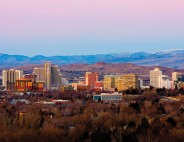
Mountain States’ Economy Outperforms National Averages
03 Aug, 2015
Interview by Rachel Duran
The nation’s economy will have a decent run during the next 12 months to 18 months.
Editor’s Note: This interview was conducted May 11, 2015. For the latest information in regard to the U.S. economic forecast, visit www.conference-board.org.
The next year and a half will find consumers and businesses in different places when it comes to the economy. Consumers see decent job growth and some see higher wages, while businesses continue to be held up by a lack of pricing power, reluctant to make capital investments.
The economy will hold up into 2016 under these tensions, says Ken Goldstein, economist, The Conference Board. How bad or mild these scenarios play out will show up in 2017 and 2018.
For the Mountain States region (Arizona, Colorado, Idaho, Montana, New Mexico, Nevada, Utah and Wyoming), challenges in the energy sector are offset by the agricultural and service sectors. The region continues to better than the country as a whole, and for the moment, will remain there.
Rachel Duran: In April, consumer confidence was down 6.2 points; and the Leading Economic Index increased slightly. Are we looking at weaker growth as we head into the summer?
 Ken Goldstein: Not as we enter the summer but perhaps by the end of the year. For the second year in a row we had a terrible winter. Not quite as bad as last year, so there may not be as strong a bounce back but certainly a bounce back in terms of consumer spending this spring and continuing into the summer.
Ken Goldstein: Not as we enter the summer but perhaps by the end of the year. For the second year in a row we had a terrible winter. Not quite as bad as last year, so there may not be as strong a bounce back but certainly a bounce back in terms of consumer spending this spring and continuing into the summer.
So to discuss a 2.5 percent economy may be disappointing to those folks hoping to see a return to 3 percent or even 4 percent GDP growth. I think those are unrealistic expectations. I think the average consumer believes so.
In addition to the weather, another factor that has been true for some time, the U.S. economy has been the strongest economy on the globe. It is beginning to tire from that role, if you like.
Another factor that has been true, which has been the case for the last 10 years, and it will not change very much, is the lack of pricing power on the part of business.
From the consumer point of view there is decent job growth and better weather will entice consumers to go on a shopping spree this spring and summer. Can it last as long as the holiday season? You are probably asking too much of the average consumer.
Duran: Describe the lack of pricing power on the part of business and what it means.
Goldstein: In terms of business investment, that very low inflation rate that the consumer enjoys is a problem for business. Are prices rising fast enough to cover costs? The answer is not by much or not at all. And what we are looking at right now is business reluctant to invest in capital and before the end of the year some reluctant on the part of some businesses to invest in human capital.
The consumer is driven by a decent if not better than decent labor market, and what our leading indicators are pointing to is that will weaken a bit as we move into the fall and winter of 2016.
Duran: At a regional level, what is the forecast for the economy of the Mountain States? These states have a lot of natural resources; what is the outlook?
Goldstein: This region of the country didn’t experience the bad winter that other areas of the country did. So what is going in the Mountain States is something a bit different. You have to start with agriculture.
In some sense what is happening in this region’s agriculture sector is a reflection of the drought out in California, which is driving demand for produce and meat output in the Mountain States. Prices are holding up well for both producers and processors.
The second key and this is a negative is what is not happening in terms of energy prices, unless you believe the worst is over and that oil prices will recover and we will go back into the range of $80 to $100 per barrel of oil. And if you believe in a recovery in the price of coal. I don’t believe this will happen.
Energy is and will remain a negative for the Mountain States perhaps through the rest of the year. It doubles down, if you like, in the sense that the nonenergy commodity sector in the Mountain States, up in Montana, as well as down in New Mexico and Arizona, their prices are even lower for metals, such as zinc, copper and iron, and even less chance that we will see a turnaround in commodity prices before the end of the year.
The Mountain States have been doing better than the country as a whole. The unemployment rate in every Mountain State but one, Nevada, is below national average. But what is going on negatively in terms of price in both the energy and in the nonenergy commodity sectors is two big drags on the economy and to the extent that it is a commodity economy, this certainly hurts.
The offset, in addition to agriculture, is what is going on in services, especially in a state like Utah, which has been more dependent on business services than commodity trading is a help.
The negatives in the Mountain States are a reflection of what is going on across the border in Canada, which is another commodity based economy. The trade between Western Canada the Mountain States is a drag on the economy.
Another drag on that region’s economy is along the southern border with the Mexican economy. Again there is more energy than nonenergy but certainly what is not going on and going well in the Mexican economy is not helping New Mexico and Arizona.
Here is the situation. The Mountain States have been stronger than the national economy. Despite the drag from energy, from nonenergy, and from trade either across the northern border or southern border, the region continues to do better than the national average, for example with low unemployment.
Will it change during the next six to nine months? Probably not. The region may not do much better than the national economy but is still strong because of agriculture and business services.
One more positive factor that is propping up the Mountain States is that out-migration of people moving from the Pacific region to the Mountain region continues.
If the national economy is on track to grow 2.5 percent or so this spring and summer and gradually move down to 2 percent rate of growth by end of the year and then stay there in 2016, there is a chance we might see the Mountain States do a few tenths of a percent better.
At the national level, for the Mountain States and for the rest of the country, we are looking at decent 12 month to 18 month run. That is good news for consumers. On the other hand business is in a period for the next 12 months to 18 months where they will struggle to not only keep profit margins, but keep them from getting squeezed too tightly by a combination of rising costs not matched by rising revenues.
The economy will hold up for the rest of this year and in 2016 under this tension. The question is how bad or how mild this will be and how it will drive us into 2017 and 2018.
For the moment we are in decent shape nationally, and a little bit more than decent shape in the Mountain States.
Ken Goldstein is an economist with The Conference Board, and can be reached by emailing goldstein@conference-board.org. The Conference Board is a global, independent business membership and research association working in the public interest. Learn more by visiting www.conference-board.org.
Illustration by Michelle Meiklejohn at Free Digital Photos.net
Related Posts
-

Nevada: Technology Diversifying & Advancing Economy
-

West North Central Midwest Improves
-

Midwest: Economy Improves, but Not Fast Enough
-

Canada’s Atlantic Provinces Will Benefit from U.S. Recovery
-

Demographics Shape New England’s Economy
-

Is the Stronger U.S. Economy Here to Stay?
-

Illinois Growing Rapidly in Diverse Directions
-

Canada: A Wealth of Opportunities; A World of Innovation










